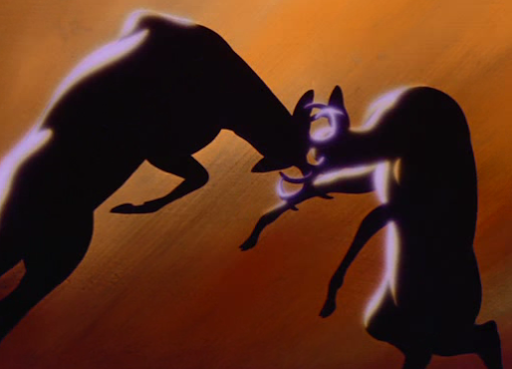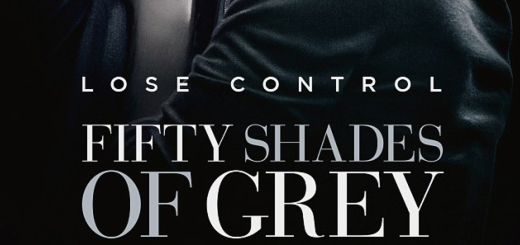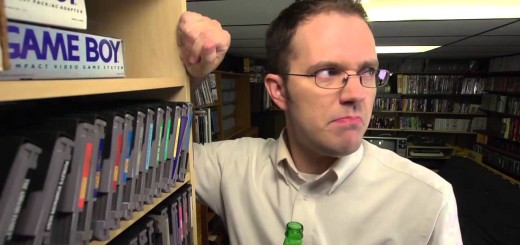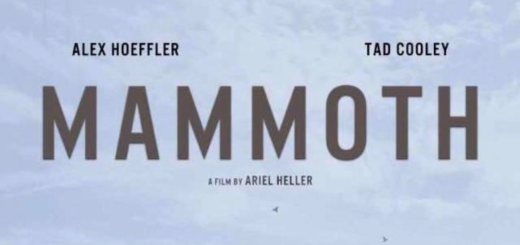THANXFDR: BAMBI
In this heartwarming seasonal series, the Crossfader staff will be running you through some of the media-related things that they’re most thankful for. Happy Thanksgiving!
You probably think you know what’s up about BAMBI. There’s this deer, he lives in the forest, he doesn’t know how to say “bird”, then his mom gets shot, and then the movie ends. Nothing special there. If that were true, would this be the number three film on AFI’s list of top ten animated films of all time? Would it have been entered into the National Film Registry at the Library of Congress or nominated for three Academy Awards? No, it wouldn’t have, and I’ll tell you why. When most people think of BAMBI, they think of this:
When I think of BAMBI, I think of this:
You may be wondering, “I don’t remember a badass fight sequence in BAMBI!” As well you shouldn’t, because I tricked you earlier: Bambi’s mother’s death (the part everyone remembers) occurs only halfway through the film. My theory is that most fragile kiddos didn’t make it past the traumatic scene; their offended parents shut the movie off shortly after it happened, or everybody just blocked out everything else in the movie. Now that we’re all grown ups, allow me to re-introduce you to one of my all-time favorite films. Rather than try to explain everything I love about this entire movie, I’m going to distill the commentary to two individual scenes so you can see what I’m talking about.
Let me start with one of my favorite scenes from the first half of the film. You’ve probably seen it before because it’s pre-deer massacre. Experience the magic:
https://www.youtube.com/watch?v=-5lu3pmHmpE&feature=youtu.be
If you want visual storytelling, look no further. The moment where Bambi mimics the galloping of the older deer is just genius. However, the visual storytelling here goes far beyond “no dialogue” because of the way the visuals work in tandem with the music. It’s clear that the animators have continued to sharpen their skills from FANTASIA (released two years prior to BAMBI) and it’s downright amazing to see how they apply the same principles to a narrative film. Bambi (and the audience) knows immediately that The Great Prince of the Forest is a huge deal because of the way he is depicted in that first image, but what really does it is the music. The crashing excitement of the gallop stops, there’s a moment of complete stillness, and the music transitions to regal horns. I even argue that the movie gets away with Bambi’s mother’s explanation because it has built sufficient intrigue, and it makes sense in context for a mother to explain something to her child – who we already know likes to ask a lot of questions. This also functions to get little three-year-old you watching this movie up to speed. We accomplished all of that in three. freaking. minutes.
You should see what I can do in four minutes
Off the above image, can we appreciate how amazing the animation is on the deer? For comparison, here’s how The Great Prince of the Forest (or GPOF for us insiders) looks in BAMBI II, a movie that I refuse to acknowledge except to illustrate how infinitely superior the original is:
I had to take a ten minute break to calm down after looking at this picture
This film began Walt Disney’s practice of bringing live animals into the studio for the animators, and the effort shows. The use of the multiplane camera is also notable in this film. This is a tool where a camera points downward through seven-or-so panes of glass, all oil painted with layers of an image. This allows for complex camera movement and a much more intricate image, almost like a diorama. This is a clear precursor to how well-made 3D movies look today. (You can really see the camera in action beginning at 2:41 in the clip).
Now, let’s observe the transition into the second half of the film. Here we have adult Bambi and his mate, Faline. Bambi has just emerged victorious from the aforementioned fight scene (which I won’t ruin for you). This is arguably my favorite scene in the movie:
If that doesn’t give you chills, you’re dead inside. First, I’d like to point out that now-adult Bambi is galloping like the stags in the first scene we saw. Second, this entire sequence is a cinematographer’s fantasy. The highlights and shadows rival some modern live action features. (It’s even more striking in the fight scene, but again, I’m not going to ruin that for you.) Third, this is hands-down the best Disney love song. If you don’t believe me, observe how much “Can You Feel The Love Tonight” draws from this scene the next time you watch THE LION KING. (Or you can just do what I do and observe how much THE LION KING draws from this entire movie.)
When presented with the opportunity to write about a piece of media I’m “thankful for”, it took me a while to decide which of my favorite films or television shows I wanted to discuss. I ultimately decided on BAMBI because it goes beyond a favorite film for me. It represents the transition from childhood to adulthood, both in terms of the story itself and my renewed appreciation for the film as a young adult. I remember playing “Bambi” at the park as a kid, and now it exists as my personal standard for storytelling as I begin a career in writing. This is the film that helps me sleep at night when MINIONS makes one billion dollars worldwide. This is exactly the kind of film I would want my kids to be watching: a film that treats its audience like adults, regardless of how young or old they are, and isn’t afraid that in-depth storytelling and intricate animation will be “lost” on the younger audience. In fact, it may shape them forever.








